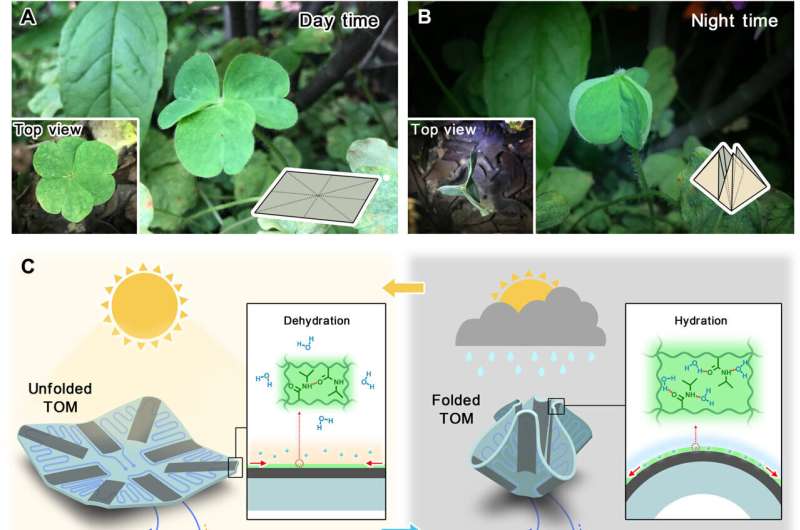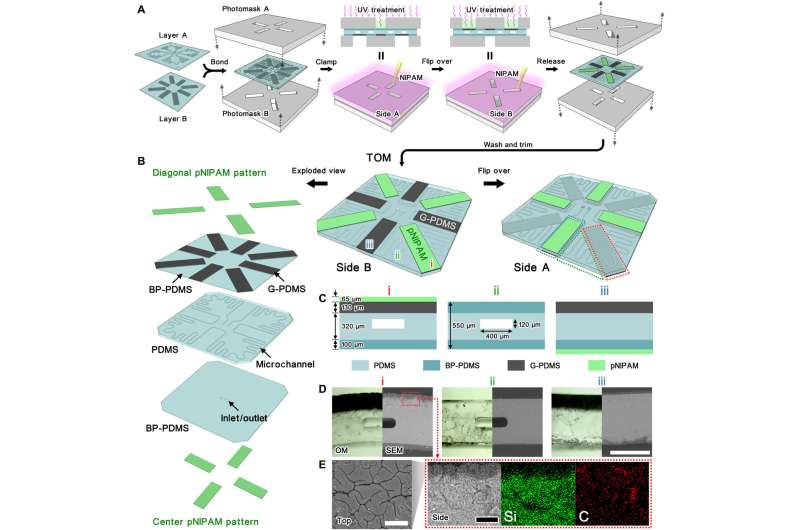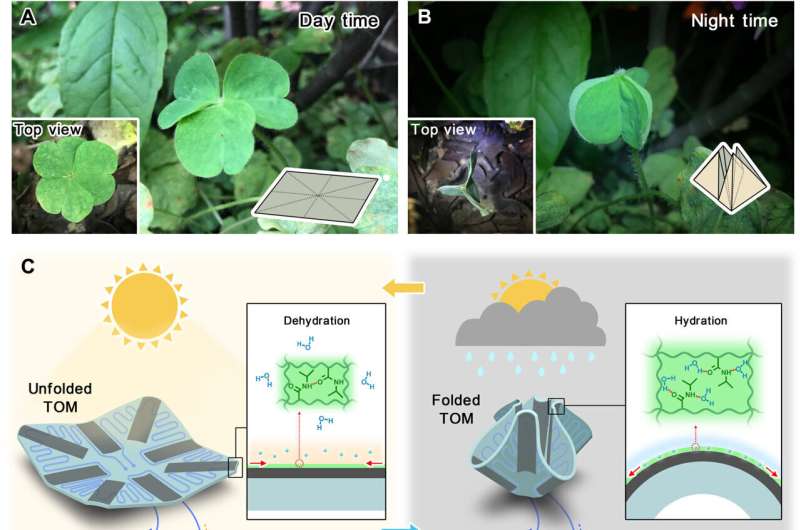Plant-inspired TOM. O. corniculata at its (A) open state during the day time and (B) close state during night time. Left insets: Top view of its open and close states, respectively. Right insets: Unfolded and folded states of the corresponding origami structure, respectively. (C) Schematic drawing of the TOM at its unfolded state when the temperature is high and light irradiates; folded state when the temperature is low and humidity is high. The insets show the schematic dehydration and hydration in the pNIPAM hydrogel layer of the actuating unit at the unfolded and folded states. (D) Bright-field images (channel is filled with blue dye) and dark-field images (channel is filled with fluorescent dye) of TOM’s two states. Scale bars, 10 mm. (E) Origami design of the TOM. Solid line indicates the folding line; dashed line indicates the edge line. Credit: Science Advances (2022). DOI: 10.1126/sciadv.abo1719
The health of a plant's vasculature depends on its capacity to respond to environmental stimuli. Plant inspired synthetic microfluidic systems have only rarely demonstrated their environmental responsiveness. In a new report now published in Science Advances, Yi Pan and a team of researchers in Mechanical Engineering at the University of Hong Kong, China, introduced bioinspired transformable microfluidics with stimuli-responsive materials embedded to respond to temperature, humidity, and light irradiance. The team designed a foldable geometry and named the device TransfOrigami microfluidics, abbreviated as TOM, to highlight the connection between its transformation and origami structure for use as an environmentally adaptive photonic reactor. The device sensed the environmental stimuli to provide positive feedback for photosynthetic conversion via morphological transformation. The team envision expanding this microsystem to broader applications, including artificial vascular networks and flexible electronics.
Bioinspired microfluidics
Plants have a rich and complex vasculature to transport water and nutrients through tissues to maintain normal metabolism. For instance, veins in leaves can deliver the nutrients produced by photosynthesis throughout the leaflet for transportation. These developments can be used to form artificial systems with embedded fluidic channels including biomimetic microfluidic devices. Plants can evolve their response to environmental changes to function well in an ever-changing natural environment. The potential to sense external environments and adjust is known as environmental adaptability relative to changes in light, temperature and humidity. In this work, Pan et al were bioinspired by plants with stimuli-responsive structures to realize this concept as a transformable microfluidic chip with stimuli-responsive materials on a thin and foldable architecture. Their TransfOrigami microfluidics method is suited for an environmentally adaptive photo-microreactor. The product can inspire applications in energy, robotics, and medicine with adaptive rhythmic movements.
Stimuli responsive transformation of the TransfOrigami microfluidic device. Credit: Science Advances, doi: 10.1126/sciadv.abo1719
Transformable origami microfluidics
The team observed the daytime plant Oxalis corniculata, which can deploy its leaflets for sun exposure and close at night by folding the leaflets. Based on this inspiration, Pan et al adopted a thin and foldable origami structure for the device. The team selected the choice of responsive materials, where silicon elastomers provided a well-established soft lithography method to support its microfabrication. They integrated stimuli-responsive morphing origami into a thin microfluidic chip to create TOM (TransfOrigami) via conventional soft lithography with some modifications. The origami structure allowed flexible conversion between a 2D flat state and a 3D compact form to create 3D fluid motion. The scientists demonstrated the concept by developing a thin microfluidic device that modified previous examples. The team first created a mold with microchannel patterns via photolithography, then spin-coated a thin-layer of polydimethylsiloxane (PDMS) pre-polymer on the mold. They repeated a similar step and developed hollowed-out regions for a resulting thin microfluidic device trimmed to the designed shape. The team partitioned the device into three regions, including diagonal actuators, light-harvesting panels, and center actuators. Then, using scanning electron microscopy, they identified the components, alongside energy dispersive X-ray mapping to confirm the constituent elements. Pan et al observed a strong adhesion between the thermal-responsive hydrogel poly (N-isopropylacrylamide) (pNIPAM) and the PDMS constituent polymers of the device. They highlighted the light transmissive regions with light-harvesting panels, while serpentine channels facilitated the device's functionality.
Stimuli-responsiveness under different conditions (a) heating on a hot plate (80 degrees Celsius), (b) irradiating under 30 klx illuminance, (c) immersing in 6 degrees Celsius water. Credit: Science Advances, doi: 10.1126/sciadv.abo1719
Environmentally responsive morphing of TransfOrigami (TOM)
The team next quantified the folding and unfolding performance of the TOM. When exposed to light irradiation, the TOM gradually unfolded, whereas in low-temperature and high humidity it gradually began to fold. Pan et al quantified the environmental responsiveness of TOM by measuring the unfold percentage under different situations under different temperatures or light illumination. The temperature continued to play a role in high humidity environments. In theory, a thicker pNIPAM actuating layer and thinner PDMS passive layer increased the degree of deformation of the TransfOrigami device. To achieve this in practice, the researchers designed the polymers to be thickest and thinnest, respectively, while including photothermal dopants such as graphene nanoplatelets to PDMS, to realize photothermal responsive actuation. The team adopted the halogen lamp as a simulator of sunlight to cover the wavelength range consistent with sunlight, excluding UV. Subsequently, photochemical reactions and thermal effects formed the photothermal conversion of the device, and the team tested them under sunny and rainy days in a natural outdoor climate, with potential for outdoor applications.
Fabrication and characterizations of TOM. (A) Fabrication of TOM. (B) Schematics show both sides of the final device and the exploded view of TOM. (C) Schematic cross sections of three regions on TOM. (D) OM and SEM of three regions. Scale bar, 500 μm. (E) SEM imaging on pNIPAM top surface and the interface between pNIPAM and G-PDMS coupled with EDX mapping. Scale bars, 100 μm. Credit: Science Advances (2022). DOI: 10.1126/sciadv.abo1719
Applications of TOM: Adaptive photosynthesis
The research team next built a setup with a syringe pump, reaction chamber and an optical flow cell to monitor photosynthesis flow through the TOM (TransfOrigami) device, to experimentally verify the effect of TOM morphing on photoreaction. During these experiments, Pan et al simplified the expected environment for photosynthesis according to the values of illuminance, temperature and humidity to adapt for diverse outputs. The more favorable conditions of photoreaction allowed higher rates of conversion to be reached. The self-sustainable system could harvest, conserve, manage and use the limited energy.
-
Temperature, light, and humidity responsiveness of TOM. (A) An illustration shows the definition of unfold percent. (B) The unfolding and folding of TOM under light irradiation [temperature (temp.) ≈ 25°C; relative humidity (R.H.) ≈ 50% RH; illumination (illum.) ≈ 30 klx] and humidified environment (temp. ≈ 6°C; R.H. ≈ 100% RH; illum. ≈ 0 klx). Scale bars, 10 mm. (C) Change in unfold percent as a function of processing time at a different temperature or light illuminance. (D) Photothermal testing of the GNPs-doped TOM and undoped TOM (illum. ≈ 30 klx). (E) Outdoor experiments monitoring the changes of unfold percent, illuminance, temperature, and humidity. Credit: Science Advances (2022). DOI: 10.1126/sciadv.abo1719
-
Adaptive photosynthesis via TOM. (A) Schematic illustration of the setup and photoreaction applied in TOM. (B) Absorption spectrum of the MB, DPA, MB and DPA, and MB and DPA treated with light. a.u., arbitrary units. (C) Comparison of conversion of TOM in folded/unfolded state in air and in water after 30-min irradiation with 6-klx illuminance, respectively. (D) The variation of the photosynthetic conversion for two states of TOM with progressive light intensity. Gray background indicates no light irradiation. The gradient from yellow to red background represents a gradient of light intensity from 2 to 8 klx. Inset: The difference between the conversions of the two morphing states (∆C) increases with higher illuminance. (E) The real-time monitoring of the conversion in two switching conditions: The normal temperature and humidity with relatively high light intensity (i.e., temp. ≈ 25°C; R.H. ≈ 50% RH; illum. ≈ 6 klx; yellow background) and low temperature and high humidity with a relatively low light intensity (i.e., temp. ≈ 6°C; R.H. ≈ 100% RH; illum. ≈ 2 klx; blue background). Gray background indicates no light irradiation. (F) Schematic illustration of the adaptive photosynthesis. Credit: Science Advances (2022). DOI: 10.1126/sciadv.abo1719
Outlook
In this way, Yi Pan and colleagues designed a morphing microfluidic device to transform from 2D to 3D, or between different 3D structures, where the dynamic switching ultimately added a dimension of time for a four dimensional (4D) concept. The 4D microfluidic device regulated fluid behavior via the reconstruction of microchannels with diverse properties, orientations, mixing efficiencies and flow rates. The pioneering, plant-inspired morphing origami microfluidics can fulfill adaptive photosynthesis by coordinating stimuli-responsive morphing-materials integrated within the setup. The team developed the construct using self-actuating elastomers responsive to ambient temperature, humidity and light irradiance. Pan et al applied the morphing to regulate photosynthetic conversion with a built-in positive feedback control in the system. The scientists envision the resulting smart microfluidics-based intelligent systems to pave the way to develop intelligent soft devices and artificial vasculature in biomedicine.
More information: Yi Pan et al, Plant-inspired TransfOrigami microfluidics, Science Advances (2022). DOI: 10.1126/sciadv.abo1719
Xiaoshi Qian et al, Artificial phototropism for omnidirectional tracking and harvesting of light, Nature Nanotechnology (2019). DOI: 10.1038/s41565-019-0562-3
Journal information: Nature Nanotechnology , Science Advances
© 2022 Science X Network


![Temperature, light, and humidity responsiveness of TOM. (A) An illustration shows the definition of unfold percent. (B) The unfolding and folding of TOM under light irradiation [temperature (temp.) ≈ 25°C; relative humidity (R.H.) ≈ 50% RH; illumination (illum.) ≈ 30 klx] and humidified environment (temp. ≈ 6°C; R.H. ≈ 100% RH; illum. ≈ 0 klx). Scale bars, 10 mm. (C) Change in unfold percent as a function of processing time at a different temperature or light illuminance. (D) Photothermal testing of the GNPs-doped TOM and undoped TOM (illum. ≈ 30 klx). (E) Outdoor experiments monitoring the changes of unfold percent, illuminance, temperature, and humidity. Credit: Science Advances (2022). DOI: 10.1126/sciadv.abo1719 Plant-inspired TransfOrigami microfluidics](https://scx1.b-cdn.net/csz/news/800a/2022/plant-inspired-transfo-2.jpg)
























